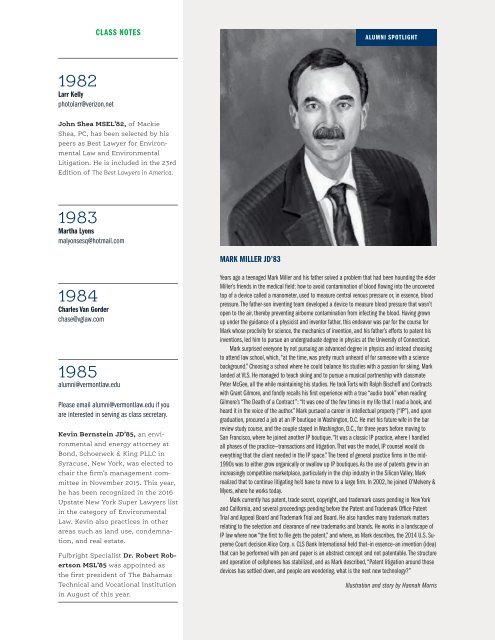In search of justice
fall2016_web
fall2016_web
Create successful ePaper yourself
Turn your PDF publications into a flip-book with our unique Google optimized e-Paper software.
CLASS NOTES<br />
ALUMNI SPOTLIGHT<br />
1982<br />
Larr Kelly<br />
photolarr@verizon.net<br />
John Shea MSEL’82, <strong>of</strong> Mackie<br />
Shea, PC, has been selected by his<br />
peers as Best Lawyer for Environmental<br />
Law and Environmental<br />
Litigation. He is included in the 23rd<br />
Edition <strong>of</strong> The Best Lawyers in America.<br />
1983<br />
Martha Lyons<br />
malyonsesq@hotmail.com<br />
MARK MILLER JD’83<br />
1984<br />
Charles Van Gorder<br />
chase@vglaw.com<br />
1985<br />
alumni@vermontlaw.edu<br />
Please email alumni@vermontlaw.edu if you<br />
are interested in serving as class secretary.<br />
Kevin Bernstein JD’85, an environmental<br />
and energy attorney at<br />
Bond, Schoeneck & King PLLC in<br />
Syracuse, New York, was elected to<br />
chair the firm’s management committee<br />
in November 2015. This year,<br />
he has been recognized in the 2016<br />
Upstate New York Super Lawyers list<br />
in the category <strong>of</strong> Environmental<br />
Law. Kevin also practices in other<br />
areas such as land use, condemnation,<br />
and real estate.<br />
Fulbright Specialist Dr. Robert Robertson<br />
MSL’85 was appointed as<br />
the first president <strong>of</strong> The Bahamas<br />
Technical and Vocational <strong>In</strong>stitution<br />
in August <strong>of</strong> this year.<br />
Years ago a teenaged Mark Miller and his father solved a problem that had been hounding the elder<br />
Miller’s friends in the medical field: how to avoid contamination <strong>of</strong> blood flowing into the uncovered<br />
top <strong>of</strong> a device called a manometer, used to measure central venous pressure or, in essence, blood<br />
pressure. The father-son inventing team developed a device to measure blood pressure that wasn’t<br />
open to the air, thereby preventing airborne contamination from infecting the blood. Having grown<br />
up under the guidance <strong>of</strong> a physicist and inventor father, this endeavor was par for the course for<br />
Mark whose proclivity for science, the mechanics <strong>of</strong> invention, and his father’s efforts to patent his<br />
inventions, led him to pursue an undergraduate degree in physics at the University <strong>of</strong> Connecticut.<br />
Mark surprised everyone by not pursuing an advanced degree in physics and instead choosing<br />
to attend law school, which, “at the time, was pretty much unheard <strong>of</strong> for someone with a science<br />
background.” Choosing a school where he could balance his studies with a passion for skiing, Mark<br />
landed at VLS. He managed to teach skiing and to pursue a musical partnership with classmate<br />
Peter McGee, all the while maintaining his studies. He took Torts with Ralph Bisch<strong>of</strong>f and Contracts<br />
with Grant Gilmore, and fondly recalls his first experience with a true “audio book” when reading<br />
Gilmore’s “The Death <strong>of</strong> a Contract ”: “It was one <strong>of</strong> the few times in my life that I read a book, and<br />
heard it in the voice <strong>of</strong> the author.” Mark pursued a career in intellectual property (“IP”), and upon<br />
graduation, procured a job at an IP boutique in Washington, D.C. He met his future wife in the bar<br />
review study course, and the couple stayed in Washington, D.C., for three years before moving to<br />
San Francisco, where he joined another IP boutique. “It was a classic IP practice, where I handled<br />
all phases <strong>of</strong> the practice—transactions and litigation. That was the model, IP counsel would do<br />
everything that the client needed in the IP space.” The trend <strong>of</strong> general practice firms in the mid-<br />
1990s was to either grow organically or swallow up IP boutiques. As the use <strong>of</strong> patents grew in an<br />
increasingly competitive marketplace, particularly in the chip industry in the Silicon Valley, Mark<br />
realized that to continue litigating he’d have to move to a large firm. <strong>In</strong> 2002, he joined O’Melveny &<br />
Myers, where he works today.<br />
Mark currently has patent, trade secret, copyright, and trademark cases pending in New York<br />
and California, and several proceedings pending before the Patent and Trademark Office Patent<br />
Trial and Appeal Board and Trademark Trial and Board. He also handles many trademark matters<br />
relating to the selection and clearance <strong>of</strong> new trademarks and brands. He works in a landscape <strong>of</strong><br />
IP law where now “the first to file gets the patent,” and where, as Mark describes, the 2014 U.S. Supreme<br />
Court decision Alice Corp. v. CLS Bank <strong>In</strong>ternational held that–in essence–an invention (idea)<br />
that can be performed with pen and paper is an abstract concept and not patentable. The structure<br />
and operation <strong>of</strong> cellphones has stabilized, and as Mark described, “Patent litigation around those<br />
devices has settled down, and people are wondering, what is the next new technology?”<br />
Illustration and story by Hannah Morris<br />
41 FALL 2015


